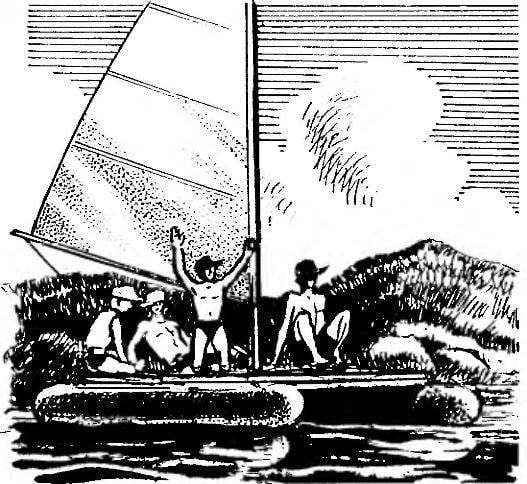The stringers are fastened to the beams shaped nuts. Compound bow (first) and aft (four) beams to the stringers is enhanced by the sleeve of smaller diameter tubing. The second and third beams, the stringers, so as not to weaken them extra holes, fastened with hooks.
Cross beam are made of pipe of larger diameter. The third transverse and the third longitudinal beams are made more durable to increase the rigidity of the vessel and the possibility of installing of sailing arms. The third cross beam is elongated to facilitate the installation of cables. Stern (fourth) beam in the place of fastening of steering is enhanced by the sleeve of larger diameter pipe. Between the third and fourth beams are put strut for fixation in the horizontal plane. Strut attached to the joists also using pins.
Steering wheel:
1 — rudder, 2 — plate (duralumin, sheet s3. 2); 3 — tiller (aluminum, pipe 25×2); 4 bracket (aluminum pipe 25×2); 5 — stretching (aluminum, pipe 22×2,2); 6 — axle (steel bar d5); 7 — axle beam, stern; 8 — strut axle; 9 — M12; 10 — M5 bolts (4 PCs.); 11,12,13,16 — M6 bolts (9 PCs.); 14 — loop cylindrical (steel, 3 pieces); 15 — loop flat (s2 steel, 3 PCs.)
All hardware is here — of stainless or galvanized steel.
The position of the holes in the stringers and transverse beams is marked in the Assembly of the catamaran is fully inflated floats. The Assembly of the catamaran is conducted in the following sequence. First collected stringers are inserted into the pockets of the floats, and the latter inflates. Standing parallel to the floats overlap the bow and stern beams, they are marked and drilled for fixing to the stringers, then—through them — the holes in the stringers. After that, beams are attached to the stringers. In the same way, set the second and third transverse beams and finally the jib.
The DECK is a rectangular cloth of thick nylon. Its dimensions are specified on the assembled frame. The perimeter edge of the cloth folded three times width of 30 mm and is stitched, then installed eyelets for attaching the deck to the bridge. Lacing is conducted from the middle of the floats to the extremities. The deck also serves as a packing for catamaran during transport, so it is advisable to sew a lining of a dense material to prevent rubbing of the fabric tubes.
The wheel of the catamaran has the feather of sheet glass with a thickness of 2 mm. the Workpiece is split into two parts with a thickness of 1 mm. For this it is the angle of the incision in the middle to a depth of 10-20 mm, and further the glass carefully, without sudden jerks, it is torn with a pair of pliers. Then the two halves are folded together and front and rear edges of drilled holes with a diameter of 1 mm by about 50 mm. Then half are fastened through these holes, soft copper wire, and between them is inserted fully assembled frame made of pipes with a diameter of 22 mm. the Sheets of fiberglass are attached to the frame at the bottom of the rivets or screws and the upper screws with countersunk heads. After this edge the helm permanently crimped wire and sealed with clay. Each edge is filled with epoxy resin. Upon completion of the polymerization, the clay along with a wire is cut with a knife, and the edge sanded. The rudder can be made of two glass fibre laminate plates with a thickness of 1 mm, but in this case must be thoroughly sanded and degreased the surfaces.
The rudder is attached with a bolt between the plates of duralumin, thickness: 3 mm, These plates are connected with the tiller, made of pipes with a diameter of 25 mm, rivets, or screws. The rudder is hung on the bracket using improvised loops. The axis of the hinge — steel rod of 5 mm diameter, removing which is easy to remove the wheel. The steering bracket is a tube attached at the top to the middle of the feed beam, and at the bottom by means of two stretch — to yosina bridge. Holes in the stretch marks and Yoshino drilled in place during Assembly of the catamaran.
The PADDLES are made of duralumin tubes of suitable diameter for easy grip, and duralumin sheets with a thickness of 1,5 mm. At the place of attachment of the blade outrigger plusits in heated form, the blade is attached to the pipe by four rivets or bolts, the ends of which are carefully clench. In the opposite end of the tube is placed a plug of foam. To ensure the flooding of the paddle on it is glued to the cushion foam, the amount of which is determined empirically.
SAILING rig has an auxiliary character and often ineffective. Therefore, its description is not given here. However, the design of the bridge of the catamaran provides for the installation, the possible position of the mast, guys and stays shown. Alternatively, sailing arms recommended design, is used on the catamaran “Altair”, published in the journal “modelist-Konstruktor” No. 7 of ’83.
TROLLEY for transportation of the catamaran may have a different design depending on the available materials. The wheels for her — from children’s bikes that are comfortable on rough terrain.
K. BELEVICH, A. GORBACHEV, Nizhniy Novgorod

